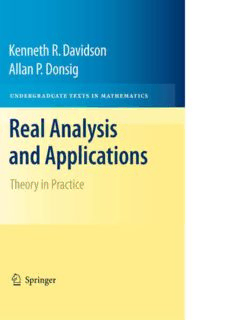Table Of ContentUndergraduate Texts in Mathematics
Editorial Board
S. Axler
K.A. Ribet
For other titles published in this series, go to
http://www.springer.com/series/666
Kenneth R. Davidson
Allan P. Donsig
Real Analysis and
Applications
Theory in Practice
Kenneth R. Davidson Allan P. Donsig
Department of Pure Mathematics Department of Mathematics
University of Waterloo University of Nebraska-Lincoln
Ontario N2L 3G1 Lincoln, NE 68588
Canada USA
[email protected] [email protected]
Editorial Board
S. Axler K.A. Ribet
Mathematics Department Mathematics Department
San Francisco State University University of California at Berkeley
San Francisco, CA 94132 Berkeley, CA 94720-3840
USA USA
[email protected] [email protected]
ISSN 0172-6056
ISBN978-0-387-98097-3 e-ISBN978-0-387-98098-0
DOI10.1007/978-0-387-98098-0
Springer New York Dordrecht Heidelberg London
Library of Congress Control Number: 2009932895
Mathematics Subject Classification (2000): 26Exx, 26E40
©SpringerScience + BusinessMedia,LLC2010
Allrightsreserved. Thisworkmaynotbetranslatedorcopiedinwholeorinpartwithoutthewritten
permissionofthepublisher(SpringerScience+BusinessMedia,LLC,233SpringStreet,NewYork,NY
10013,USA),exceptforbriefexcerptsinconnectionwithreviewsorscholarlyanalysis.Useinconnection
withanyformofinformationstorageandretrieval,electronicadaptation,computersoftware,orbysimilar
ordissimilarmethodologynowknownorhereafterdevelopedisforbidden.
Theuseinthispublicationoftradenames,trademarks,servicemarks,andsimilarterms,eveniftheyare
notidentifiedassuch,isnottobetakenasanexpressionofopinionastowhetherornottheyaresubject
toproprietaryrights.
Printedonacid-freepaper
Springer is part of Springer Science+Business Media (www.springer.com)
ToVirginiaandStephanie
Preface
Thisbookprovidesanintroductionbothtorealanalysisandtoarangeofimportant
applications that depend on this material. Three-fifths of the book is a series of
essentiallyindependentchapterscoveringtopicsfromFourierseriesandpolynomial
approximation to discrete dynamical systems and convex optimization. Studying
theseapplicationscan,webelieve,bothimproveunderstandingofrealanalysisand
prepareformoreintensiveworkineachtopic.Thereisenoughmaterialtoallowa
choiceofapplicationsandtosupportcoursesatavarietyoflevels.
ThisbookisasubstantialrevisionofRealAnalysiswithRealApplications,which
waspublishedin2001byPrenticeHall.Themajorchangeinthisversionisagreater
emphasis on the latter part of the book, focussed on applications. A few of these
chapterswouldmakeagoodsecondcourseinrealanalysisthroughtheopticofone
ormoreappliedareas.Anysinglechaptercanbeusedforaseniorseminar.
Thefirstpartofthebookcontainsthecoreresultsofafirstcourseinrealanalysis.
This background is essential to understanding the applications. In particular, the
notionsoflimitandapproximationaretwosidesofthesamecoin,andthisinterplay
iscentraltothewholebook.Severaltopicsnotneededfortheapplicationsarenot
included in the book but are available online, at both this book’s official website
www.springer.com/978-0-387-98097-3andourownpersonalwebsites,
www.math.uwaterloo.ca/∼krdavids/and
www.math.unl.edu/∼adonsig1/.
Theapplicationshavebeenchosenfrombothclassicalandmoderntopicsofin-
terestinappliedmathematicsandrelatedfields.Ourgoalistodiscussthetheoretical
underpinnings of these applied areas, showing the role of the fundamental princi-
ples of analysis. This is not a methods course, although some familiarity with the
computationalormethods-orientedaspectsofthesetopicsmayhelpthestudentap-
preciate how the topics are developed. In each application, we have attempted to
gettoanumberofsubstantialresults,andtoshowhowtheseresultsdependonthe
theory.
Thisbookbeganin1984whenthefirstauthorwroteashortsetofcoursenotes
(120pages)forarealanalysisclassattheUniversityofWaterloodesignedforstu-
dentswhocameprimarilyfromappliedmathandcomputerscience.Theideawasto
vii
viii Preface
gettothebasicresultsofanalysisquickly,andthenillustratetheirroleinavariety
ofapplications.Atthattime,theapplicationswerelimitedtopolynomialapproxi-
mation,Newton’smethod,differentialequations,andFourierseries.
Aplanevolvedtoexpandthesenotesintoatextbooksuitableforaone-ortwo-
semestercourse.Weexpandedboththetheoreticalsectionandthechoiceofappli-
cations in order to make the text more flexible. As a consequence, the text is not
uniformly difficult. The material is arranged by topic, and generally each chapter
getsmoredifficultasoneprogressesthroughit.Theinstructorcanomitsomemore
difficulttopicsintheearlychaptersiftheywillnotbeneededlater.
Weemphasizetheroleofnormedvectorspacesinanalysis,sincetheyprovidea
naturalframeworkformostoftheapplications.Sosomeknowledgeoflinearalgebra
isneeded.Ofcourse,thereaderalsoshouldhaveareasonableworkingknowledge
ofdifferentialandintegralcalculus.Whilemultivariablecalculusisanassetbecause
oftheincreasedlevelofsophisticationandtheincorporationoflinearalgebra,itis
notessential.Someofthisbackgroundmaterialisoutlinedinthereviewchapter.
By and large, the various applications are independent of each other. However,
therearereferencestomaterialinotherchapters.Forexample,inthewaveletschap-
ter(Chapter15),itseemsessentialtomakecomparisonswiththeclassicalapproxi-
mationresultsforFourierseriesandforpolynomials.
It is possible to use an application chapter on its own for a student seminar or
topics course. We have included several modern topics of interest in addition to
the classical subjects of applied mathematics. The chapter on discrete dynamical
systems (Chapter 11) introduces the notions of chaos and fractals and develops a
numberofexamples.Thechapteronwavelets(Chapter15)illustratestheideaswith
theHaarwavelet.Itcontinueswithaconstructionofwaveletsofcompactsupport,
andgivesacompletetreatmentofasomewhateasiercontinuouswavelet.Inthefinal
chapter(Chapter16),westudyconvexoptimizationandconvexprogramming.Both
oftheselatterchaptersrequiremorelinearalgebrathantheothers.
We would like to thank various people who worked with early versions of this
bookfortheirhelpfulcomments,inparticular,RobertAndre´,JohnBaker,JonBor-
wein, Ola Bratteli, Brian Forrest, John Holbrook, Stephen Krantz, Michael Lam-
oureux, Leo Livshits, Mike McAsey, Robert Manning, John Orr, Justin Peters,
GabrielPrajitura,DavidSeigel,EdVrscay,andFrankZorzitto.Wealsothankour
students Geoffrey Crutwell, Colin Davidson, Sean Desaulniers, Masoud Kamgar-
pour, Michael Lipnowski, and Alex Wright for working through parts of the book
andsolvingmanyoftheexercises.Wealsothankthestudentsinvariousclassesat
theUniversityofWaterlooandattheUniversityofNebraska,whereearlyversions
ofthetextwereusedandtested.
Wewelcomecommentsonthisbook.
Waterloo,ON&Lincoln,NE KennethR.Davidson
March,2009 AllanP.Donsig
Contents
PartA Analysis
1 Review ........................................................ 3
1.1 Calculus.................................................. 3
1.2 LinearAlgebra ............................................ 5
1.3 Appendix:EquivalenceRelations............................. 7
2 TheRealNumbers.............................................. 9
2.1 AnOverviewoftheRealNumbers ........................... 9
2.2 TheRealNumbersandTheirArithmetic....................... 10
2.3 TheLeastUpperBoundPrinciple ............................ 13
2.4 Limits ................................................... 15
2.5 BasicPropertiesofLimits................................... 19
2.6 MonotoneSequences....................................... 20
2.7 Subsequences ............................................. 23
2.8 CauchySequences ......................................... 27
2.9 CountableSets ............................................ 31
3 Series ......................................................... 35
3.1 ConvergentSeries.......................................... 35
3.2 ConvergenceTestsforSeries ................................ 39
3.3 AbsoluteandConditionalConvergence........................ 44
ix
x Contents
4 TopologyofRn ................................................. 48
4.1 n-DimensionalSpace....................................... 48
4.2 ConvergenceandCompletenessinRn ......................... 52
4.3 ClosedandOpenSubsetsofRn .............................. 56
4.4 CompactSetsandtheHeine–BorelTheorem ................... 61
5 Functions...................................................... 67
5.1 LimitsandContinuity ...................................... 67
5.2 DiscontinuousFunctions.................................... 72
5.3 PropertiesofContinuousFunctions ........................... 77
5.4 CompactnessandExtremeValues ............................ 80
5.5 UniformContinuity ........................................ 82
5.6 TheIntermediateValueTheorem ............................. 88
5.7 MonotoneFunctions ....................................... 90
6 DifferentiationandIntegration................................... 94
6.1 DifferentiableFunctions .................................... 94
6.2 TheMeanValueTheorem................................... 99
6.3 RiemannIntegration........................................103
6.4 TheFundamentalTheoremofCalculus........................109
7 NormsandInnerProducts.......................................113
7.1 NormedVectorSpaces......................................113
7.2 TopologyinNormedSpaces.................................117
7.3 Finite-DimensionalNormedSpaces...........................120
7.4 InnerProductSpaces .......................................124
7.5 FiniteOrthonormalSets ....................................128
7.6 FourierSeries .............................................132
7.7 OrthogonalExpansionsandHilbertSpaces.....................136
8 LimitsofFunctions .............................................142
8.1 LimitsofFunctions ........................................142
8.2 UniformConvergenceandContinuity .........................147
8.3 UniformConvergenceandIntegration.........................150
8.4 SeriesofFunctions.........................................154
8.5 PowerSeries ..............................................161
8.6 CompactnessandSubsetsofC(K)............................168
9 MetricSpaces ..................................................175
9.1 DefinitionsandExamples ...................................175
9.2 CompactMetricSpaces.....................................180
9.3 CompleteMetricSpaces ....................................183
Contents xi
PartB Applications
10 ApproximationbyPolynomials...................................189
10.1 TaylorSeries..............................................189
10.2 HowNottoApproximateaFunction..........................198
10.3 Bernstein’sProofoftheWeierstrassTheorem ..................201
10.4 AccuracyofApproximation .................................204
10.5 ExistenceofBestApproximations............................207
10.6 CharacterizingBestApproximations ..........................211
10.7 ExpansionsUsingChebyshevPolynomials.....................217
10.8 Splines...................................................223
10.9 UniformApproximationbySplines...........................231
10.10 TheStone–WeierstrassTheorem .............................235
11 DiscreteDynamicalSystems .....................................240
11.1 FixedPointsandtheContractionPrinciple .....................241
11.2 Newton’sMethod..........................................252
11.3 OrbitsofaDynamicalSystem ...............................257
11.4 PeriodicPoints ............................................262
11.5 ChaoticSystems...........................................269
11.6 TopologicalConjugacy .....................................277
11.7 IteratedFunctionSystems...................................285
12 DifferentialEquations...........................................293
12.1 IntegralEquationsandContractions ..........................293
12.2 CalculusofVector-ValuedFunctions..........................297
12.3 DifferentialEquationsandFixedPoints .......................300
12.4 SolutionsofDifferentialEquations ...........................304
12.5 LocalSolutions............................................309
12.6 LinearDifferentialEquations ................................316
12.7 PerturbationandStabilityofDEs.............................320
12.8 ExistenceWithoutUniqueness ...............................324
13 FourierSeriesandPhysics.......................................328
13.1 TheSteady-StateHeatEquation..............................328
13.2 FormalSolution ...........................................332
13.3 ConvergenceintheOpenDisk ...............................334
13.4 ThePoissonFormula.......................................337
13.5 Poisson’sTheorem.........................................341
13.6 TheMaximumPrinciple ....................................345
13.7 TheVibratingString(FormalSolution)........................347
13.8 TheVibratingString(RigorousSolution) ......................353
13.9 Appendix:TheComplexExponential .........................356
Description:This new approach to real analysis stresses the use of the subject in applications, showing how the principles and theory of real analysis can be applied in various settings. Applications cover approximation by polynomials, discrete dynamical systems, differential equations, Fourier series and physi

